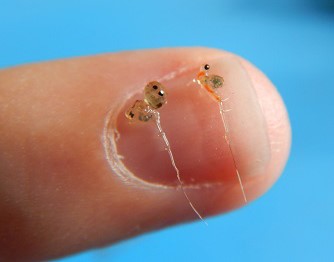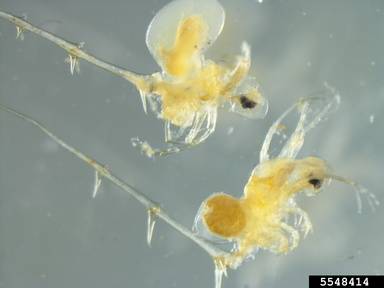Spiny Waterflea
| Spiny Waterflea | ||
|
Spiny waterflea is a tiny invasive species that can have a significant impact on the aquatic food chain of waterways. Adults range from 1/4 to 5/8 inches long. Its long spine makes it inedible for small fish. This tiny aquatic animal is native to Europe and Asia.
Spiny waterfleas originally arrived in the Great Lakes aroudn 1982 through the ballast water of cruise ships, tankers and cargo carriers. Ballast water is water taken on or discharged by ships for stability, often resulting in organisms getting caught up in the ballasts and inadvertently moved from one region to another. Spiny waterfleas spread by attaching to fishing lines, anchor ropes, and fishing nets and hitching rides to other waterbodies. They can also be transported in bilge water, bait buckets, live wells, and the bottoms of canoes and kayaks.
Why is it bad?
Ecologic damage. – The spiny waterflea alters the food availability for fish. The spiny waterflea eats the small native zooplankton that are important food for native fish, such as perch and walleye. In some lakes, they have eliminated native zooplankton from the food chain, causing serious declines in native fish populations. Their tail spines prevent small fish from eating spiny waterfleas and may puncture the stomach lining of larger fish. In addition, waterfleas degrade recreation by catching on fishing gear and lines, posing a nuisance to anglers.
Spiny waterfleas pose no harm to drinking water or human health.
Spiny waterflea has already been discovered in Lake Pleasant, Sacandaga Lake, Piseco Lake, and Indian Lake. We want to help prevent the spread of this invasive critter to other Adirondack lakes that have not yet been invaded by this pest. After an invasive species becomes established in a new environment, it can be very difficult to eradicate the invader. Hence, prevention is the best defense against invasive species, to keep them from being introduced to areas where they do not belong. At this time, there is no known treatment to remove spiny waterflea after it finds a home in a new lake. Hence, it is important to employ the CLEAN – DRAIN – DRY protocol for any boats, fishing equipment, or other sports equipment that you move from one lake to another. Spiny waterfleas and their eggs can be transported easily on fishing gear and anchor lines, and through bait buckets and bilge water.
CLEAN: Whenever leaving a waterway, inspect watercraft and gear and remove aquatic plants and animals, including mud and algae and dispose away from the shoreline.
DRAIN: Drain all water from live-wells, bait buckets, bilges, and other reservoirs.
DRY: Allow boat and equipment to completely dry before using it in another waterway. If drying is not an option, take advantage of the free boat wash stations throughout the Adirondacks. Boats and equipment can be cleaned with 140-degree hot water, which will kill the waterfleas and their eggs, as well as other invasive species.
Remember that this applies to canoes and kayaks, as well as power boats and personal watercraft (PWCs, or jet skis). You can help Stop Aquatic Hitchhikers! = = = = = = = = = = = = = = = = = = = = = = = =
More information is available at these websites: |
||
 |
||
|
| Spiny Waterflea | ||
|
Spiny waterflea is a tiny invasive species that can have a significant impact on the aquatic food chain of waterways. Adults range from 1/4 to 5/8 inches long. Its long spine makes it inedible for small fish. This tiny aquatic animal is native to Europe and Asia.
Spiny waterfleas originally arrived in the Great Lakes around 1982 through the ballast water of cruise ships, tankers and cargo carriers. Ballast water is water taken on or discharged by ships for stability, often resulting in organisms getting caught up in the ballasts and inadvertently moved from one region to another. Spiny waterfleas spread by attaching to fishing lines, anchor ropes, and fishing nets and hitching rides to other waterbodies. They can also be transported in bilge water, bait buckets, live wells, and the bottoms of canoes and kayaks.
Why is it bad?
Ecologic damage. – The spiny waterflea alters the food availability for fish. The spiny waterflea eats the small native zooplankton that are important food for native fish, such as perch and walleye. In some lakes, they have eliminated native zooplankton from the food chain, causing serious declines in native fish populations. Their tail spines prevent small fish from eating spiny waterfleas and may puncture the stomach lining of larger fish. In addition, waterfleas degrade recreation by catching on fishing gear and lines, posing a nuisance to anglers.
Spiny waterfleas pose no harm to drinking water or human health.
Spiny waterflea has already been discovered in Lake Pleasant, Sacandaga Lake, Piseco Lake, and Indian Lake. We want to help prevent the spread of this invasive critter to other Adirondack lakes that have not yet been invaded by this pest. After an invasive species becomes established in a new environment, it can be very difficult to eradicate the invader. Hence, prevention is the best defense against invasive species, to keep them from being introduced to areas where they do not belong. At this time, there is no known treatment to remove spiny waterflea after it finds a home in a new lake. Hence, it is important to employ the CLEAN – DRAIN – DRY protocol for any boats, fishing equipment, or other sports equipment that you move from one lake to another. Spiny waterfleas and their eggs can be transported easily on fishing gear and anchor lines, and through bait buckets and bilge water.
CLEAN: Whenever leaving a waterway, inspect watercraft and gear and remove aquatic plants and animals, including mud and algae and dispose away from the shoreline.
DRAIN: Drain all water from live-wells, bait buckets, bilges, and other reservoirs.
DRY: Allow boat and equipment to completely dry before using it in another waterway. If drying is not an option, take advantage of the free boat wash stations throughout the Adirondacks. Boats and equipment can be cleaned with 140-degree hot water, which will kill the waterfleas and their eggs, as well as other invasive species.
Remember that this applies to canoes and kayaks, as well as power boats and personal watercraft (PWCs, or jet skis). You can help Stop Aquatic Hitchhikers! = = = = = = = = = = = = = = = = = = = = = = = =
More information is available at these websites: |
||
 |
||
|






